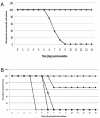Isolation and mutagenesis of a capsule-like complex (CLC) from Francisella tularensis, and contribution of the CLC to F. tularensis virulence in mice
- PMID: 21544194
- PMCID: PMC3081320
- DOI: 10.1371/journal.pone.0019003
Isolation and mutagenesis of a capsule-like complex (CLC) from Francisella tularensis, and contribution of the CLC to F. tularensis virulence in mice
Abstract
Background: Francisella tularensis is a category-A select agent and is responsible for tularemia in humans and animals. The surface components of F. tularensis that contribute to virulence are not well characterized. An electron-dense capsule has been postulated to be present around F. tularensis based primarily on electron microscopy, but this specific antigen has not been isolated or characterized.
Methods and findings: A capsule-like complex (CLC) was effectively extracted from the cell surface of an F. tularensis live vaccine strain (LVS) lacking O-antigen with 0.5% phenol after 10 passages in defined medium broth and growth on defined medium agar for 5 days at 32°C in 7% CO₂. The large molecular size CLC was extracted by enzyme digestion, ethanol precipitation, and ultracentrifugation, and consisted of glucose, galactose, mannose, and Proteinase K-resistant protein. Quantitative reverse transcriptase PCR showed that expression of genes in a putative polysaccharide locus in the LVS genome (FTL_1432 through FTL_1421) was upregulated when CLC expression was enhanced. Open reading frames FTL_1423 and FLT_1422, which have homology to genes encoding for glycosyl transferases, were deleted by allelic exchange, and the resulting mutant after passage in broth (LVSΔ1423/1422_P10) lacked most or all of the CLC, as determined by electron microscopy, and CLC isolation and analysis. Complementation of LVSΔ1423/1422 and subsequent passage in broth restored CLC expression. LVSΔ1423/1422_P10 was attenuated in BALB/c mice inoculated intranasally (IN) and intraperitoneally with greater than 80 times and 270 times the LVS LD₅₀, respectively. Following immunization, mice challenged IN with over 700 times the LD₅₀ of LVS remained healthy and asymptomatic.
Conclusions: Our results indicated that the CLC may be a glycoprotein, FTL_1422 and -FTL_1423 were involved in CLC biosynthesis, the CLC contributed to the virulence of F. tularensis LVS, and a CLC-deficient mutant of LVS can protect mice against challenge with the parent strain.
Conflict of interest statement
Figures











References
-
- Dennis DT, Inglesby TV, Henderson DA, Bartlett JG, Ascher MS, et al. Tularemia as a biological weapon: medical and public health management. JAMA. 2001;285:2763–2773. - PubMed
-
- Penn RL. Francisella tularensis (Tularemia). In: Mandell GL, Bennett JE, Dolin R, editors. Mandell, Douglas, and Bennett's Principals and Practice of Infectious Diseases. 6th ed. Philadelphia: Elsevier Churchill Livingstone; 2005. pp. 2674–2685.
Publication types
MeSH terms
Substances
Grants and funding
LinkOut - more resources
Full Text Sources
Miscellaneous

